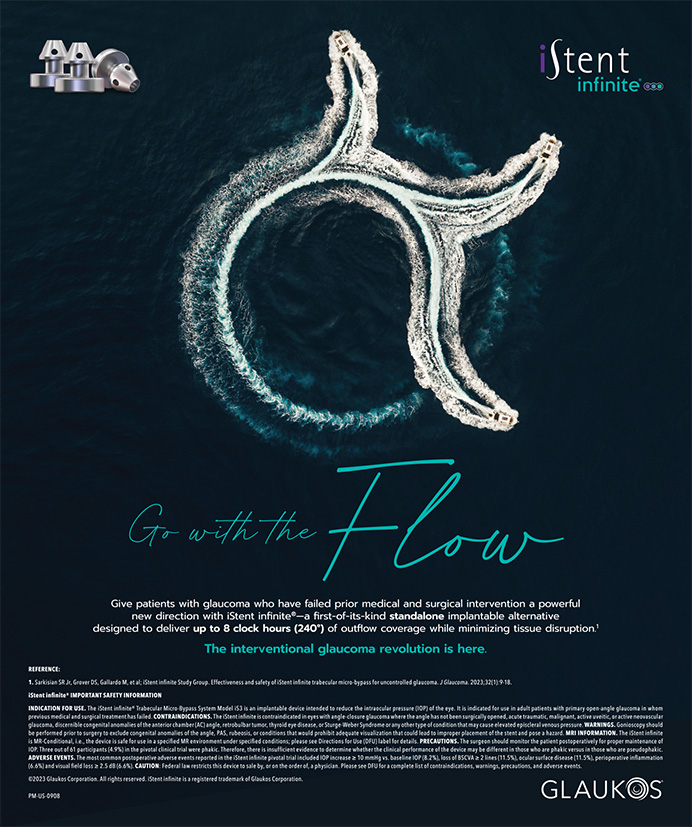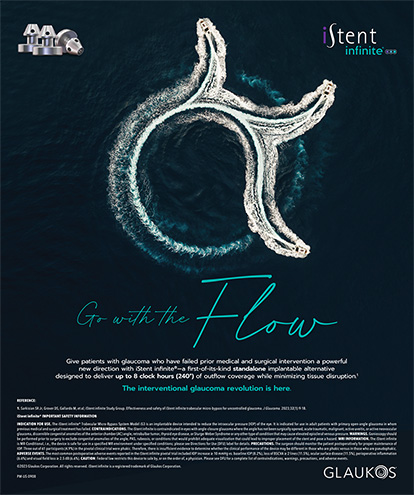
A distinguished cast of pioneers is responsible for inventing, introducing, improving, and shepherding through the regulatory process the ground-breaking techniques and devices behind today’s remarkable refractive-cataract and corneal procedures. David F. Muller, PhD, MBA, is among a handful of visionaries who are associated with the commercialization of not one but two of these “game-changers”: laser vision correction and corneal collagen cross-linking (CXL). Well known in the ophthalmic field, Dr. Muller is the physicist and serial entrepreneur who headed Summit Technology when it was the first company to gain FDA approval of an excimer laser for PRK. This regulatory milestone gave a generation of baby boomers who were hungry for a minimally invasive solution to spectacle dependence their first taste of what has evolved into today’s customized laser vision correction procedure. Dr. Muller reaped the financial rewards of satisfying the pent-up demand for laser refractive surgery during its pre-recessionary heyday—Summit was bought by Alcon for $980 million—but he also sustained scathing personal attacks by critics in need of a scapegoat on whom to pin the growing number of reports of LASIK-induced corneal ectasia.
At that point, Dr. Muller took his piggy bank and entrepreneurial spirit far away from eye surgery and the medical device arena. He bought a dairy farm in Vermont and a herd of water buffalo (a stint in veterinary school after leaving Summit came in handy here, he says), and he spent several years researching and perfecting the ways of whey. Along with the help of talent imported from Italy—and against all climatic and economic odds—he produced award-winning mozzarella and gourmet yogurt about which culinary bloggers and dairy aficionados still rhapsodize. Dr. Muller followed that unlikely detour with forays into a variety of disparate industries but ultimately circled back to the ophthalmic field and his current incarnation as CEO of Avedro and a champion of CXL.
CXL is far from new. The procedure was first described in the literature 20 years ago and has been reported on extensively in more than 500 articles. Developed in Germany in the late 1990s, CXL combines the delivery of ultraviolet light and riboflavin eye drops to stabilize the cornea, which limits the progression of keratoconus and, in many cases, allows patients with keratoconus to transition from hard scleral lenses to soft contact lenses. The Eye Bank Association of America has estimated that approximately 25% to 40% of corneal transplants performed on kerataconus patients could be eliminated if CXL were approved in the United States. Recognizing the market potential of the procedure, Dr. Muller launched Avedro in 2007. The company acquired the rights to CXL studies performed by a prior sponsor, added to those data, and submitted a premarket approval application (PMA) to the FDA. During that process, the company introduced several advances, some aimed at the refractive market (Accelerated Cross-Linking, pulsed illumination, Lasik Xtra, and Photorefractive Intrastromal Cross-Linking [PiXL]). It also recently acquired the assets of IROC Innocross, which was the first company to commercialize a cross-linking device for the treatment of keratoconus and other corneal pathologies.
Avedro’s CXL therapy is approved in 60 countries outside the United States, but FDA approval of Avedro’s drug-device combination remains elusive, to the dismay of Dr. Muller and legions of stakeholders in the ophthalmic community. The use of CXL has become relatively common here, however, with surgeons relying on pharmacy-compounded versions of riboflavin in combination with phototherapy devices approved for other uses.
Dr. Muller earned a doctorate in physical chemistry from Cornell University and an MBA from The Wharton School of the University of Pennsylvania, he is the author of publications in the areas of photochemistry and excimer laser development, and he holds numerous patents in the medical device field. He is unique among the suits on the corporate side and the scrubs on the clinical side. Some criticize his bravado. Others laud his brilliance. Most appreciate his ability to recognize and commoditize the next big thing.
A SURPRISING DECISION
CRST: In late February, a joint panel of the FDA voted to recommend approval of Avedro’s CXL platform. (The panel voted 10-4 with one abstention to endorse it for progressive keratoconus and 6-4 with 4 abstentions and 1 uncast vote for corneal ectasia.) In March, however, the FDA did not approve. What happened, and what is next?
David Muller: The FDA identified a small number of areas of the application concerning the device that require additional information, none of which pertains to the clinical study’s safety or efficacy data.
CRST: What was it about the device that they questioned?
DM: The clinical trials were done using the IROC UV 1000 device, but the KXL system was the device that we requested approval of in our NDA. We believe these systems are basically equivalent, because the only important thing is the beam (ie, its shape and fluence on the eye in the corneal plane). We believe that the KXL is equivalent to the UVX 1000, and that’s the issue that we’re dealing with with the FDA now. It comes down to a device equivalency issue.
CRST: When do you expect approval?
DM: We are not sure. We are still hoping that it will get approved in the United States for basic keratoconus this year.
CRST: What is the status of Avedro’s efforts in CXL outside the United States?
DM: Avedro has two devices that we are commercializing outside the United States. We have the KXL System, which is for basic CXL, and we have the Mosaic System. The Mosaic System allows for customized photography-guided cross-linking rather than just large-area CXL. For keratoconus patients, it provides a much better treatment, because it allows [the physician] to work toward [normalizing] the cornea. For refractive treatments, it looks like it should have a strong initial market in patients with low myopia and for post-IOL refractive tune-ups.
NEXT STEPS
CRST: What is the market potential for the KXL System and the Mosaic System?
DM: Outside the United States, I would estimate that the number of KXL treatments for kerataconus alone would be somewhere on the order of 100,000 per year. The number of PiXL refractive procedures for low myopes and IOL tune-ups that could be done with the Mosaic System around the world would be in the neighborhood of 8 to 10 million cases a year.
CRST: That is impressive; what is the source of those estimates?
DM: PiXL is a refractive procedure that addresses a part of the refractive market, the low myopes, mostly less than 2.00 D. There are many more people who have 2.00 D and under of myopia, for example, a large part of the contact lens population, than there are who have 4.00 D of myopia. The potential patient population is much bigger than it was for LASIK, which was huge. In addition to that group, almost half the patients who get cataract surgery could use a form of a corneal touchup, and this would provide surgeons with a much easier, noninvasive, nonsurgical way to do that than the way it is done now. The cataract patients alone could represent 4 to 5 million patients around the world every year.
CRST: Can CXL also be used to reduce the likelihood of refractive surgery-induced ectasia?
DM: We have done refractive tune-ups for patients who have had PRK and did not achieve the best results. When we tune up [patients], we do not have to remove any tissue, so it is good for that. Right now, most of it is really just keratoconus.
CRST: You recently reported that 16 patients treated purely for refractive error had bilateral PiXL treatment with the Mosaic System and achieved successful outcomes. Do you have any additional details to share?
DM: First, I should point out that there are 10-year results using CXL for keratoconus that, along with all the other data that are available, show that CXL is a safe, effective, stable procedure for adjusting the corneal biomechanics.
As far as refractive outcomes, we have been treating visually impaired and [blind] patients for almost 2 years, so we know that we can induce a refractive change and have it be stable over that period of time. We have made refractive changes in corneas and have shown those to be stable now for at least 18 months.
Based on those outcomes, we felt confident to move ahead to normally sighted eyes. These normally sighted eyes are all low-diopter patients, but each case is within 0.50 D of the intended correction. The patients see well, and we have shown stability from 1 month post-PiXL up to about 9 months, when the patients do not show any change from the initial induced effect. I should add that this is all outside the United States.
OTHER ROLES FOR CXL?
CRST: What potential roles could CXL play in the nontherapeutic realm?
DM: It could apply to treating myopia, astigmatism, and even hyperopia. Roy and Dupps1 have performed finite elemental analysis modeling on the PiXL effect, and it predicts that the technology should be able to make corrections up to 4.00 D, so if we are being conservative, I would say it could be used to treat 3.00 D and under of myopia, astigmatism, and hyperopia, which includes patients who wear contact lenses and thin spectacles. There is also the second market, which is the post-IOL refractive errors, where CXL could be used instead of LASIK to tweak the refractive outcome.
CRST: Could CXL replace just about every refractive laser on the market?
DM: No, the LASIK population is skewed to higher diopters, and CXL is skewed to lower diopters. LASIK can treat low-diopter [refractive errors], too, but [these patients] do not come in for LASIK, because they do not want surgery. They are, however, interested in CXL, because it is not surgery; it is a noninvasive procedure.
CRST: How widespread has the adoption of PiXL been so far?
DM: The PiXL system is only just rolling out commercially; there are half a dozen in use. Most of those treatments so far have been for further improving the results of keratoconic patients who had already been treated with CXL, because [when] using the topography-guided PiXL treatment on [eyes with] keratoconus, you get a much better result. Outside the United States, the standard of care for treating keratoconus is CXL, and we are taking it to the next level by adding the topography-guided aspect.
CRST: Will CXL used for refractive purposes or to tweak IOL outcomes be less expensive for patients than laser treatments?
DM: I do not know. Surgery or “surgery-like” interventions are like art: you don’t pay for the paint; you pay for the result. So at this point, I am really not sure where it is going to end up as far as the patient’s cost.
CRST: Do you think CXL for refractive or IOL-tweaking purposes will have to be repeated a few times in a person’s lifetime?
DM: We are not really sure. The 10-year keratoconus results suggest that that is not the case. Assuming that it is performed [with the] epithelium on, then it really would not be that big a deal if a tune-up were needed. All of the other current refractive procedures involve some weakening of the cornea, either intentionally or unintentionally. The cornea is made weaker because the eyes were cut, the tissue [was] removed, and the like. PiXL is different from any other refractive procedure in that it works by strengthening the cornea rather than weakening it. It is a much more positive intervention.
WHICH TECHNIQUE?
CRST: There is an ongoing debate about the relative advantages and disadvantages of the epithelium-on (epi-on) and epithelium-off (epi-off) techniques. Proponents of transepithelial CXL say that leaving the epithelium intact offers quicker healing and reduces risk, and they express concern that the Avedro clinical trial data used for its NDA relied on the epi-off technique. What are your thoughts?
DM: It is important to keep in mind that the only true randomized clinical trials in CXL that have ever been done are ours in the United States with the epi-off technique. So when people talk about how well the epi-on technique works, those are anecdotal, observational comments. If you look at the literature from outside the United States where people with no personal agenda have analyzed the data carefully, you will see that epi-on currently does not work as well as epi-off.2 There is no question about it. Anything to the contrary cannot be supported by facts. Everybody wants epi-on to work, so there is a sort of emotional prejudice to looking at the data and saying, “Look, it works.” Epi-on is a little less invasive, but it is also a little less effective than epi-off; in many cases, that does not matter. Part of the problem is that keratoconus is represented by a very heterogeneous population. If you have somebody with a very bad cone, epi-on can give you a result that looks pretty good, but the absolute fact is that, if you [had] scrape[d] the [epithelium] off, you would have gotten an even better result.
CRST: You have been the target of tremendous backlash from LASIK critics and others who have an axe to grind about the minutiae involved in the FDA’s approval of LASIK. How do you deal with that?
DM: The thing is, when I developed Summit Technology, I developed PRK. LASIK did not come along until 4 years after I left the company, so I really had nothing to do with it. I just get tarpapered with that. Somebody told me once a long time ago [that] you can’t make an omelet without breaking a few eggs. n
1. Roy AS, Dupps WJ. Patient specific computational modeling of keratoconus progression and differential responses to collagen cross-linking. Invest Ophthalmol Vis Sci. 2011;52(12):9174-9187.
2. Kocak I, Aydin A, Kaya F, Koc H. Comparison of transepithelial corneal collagen crosslinking with epithelium-off crosslinking in progressive keratoconus. J Fr Ophtalmol. 2014;37(5):371-376.
Rochelle Nataloni
• freelance medical writer with 25 years’ experience specializing in eye care, aesthetics, and practice management
• (856) 401-8859; rnk2020@comcast.net; Twitter @JustRochelleN; www.linkedin.com/in/rochellenataloni


